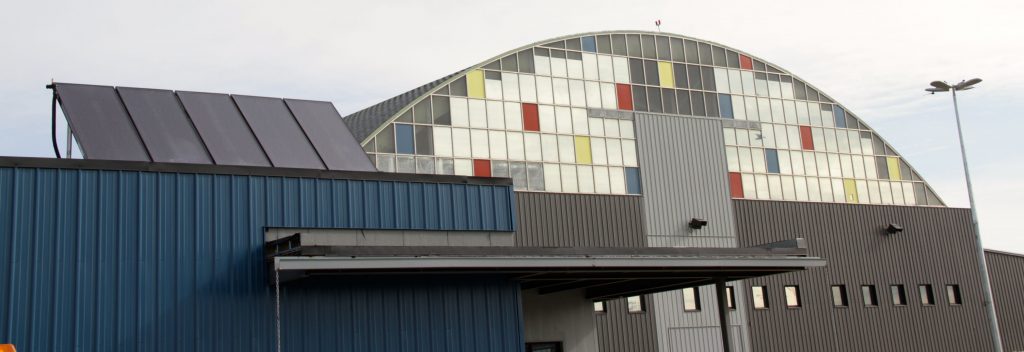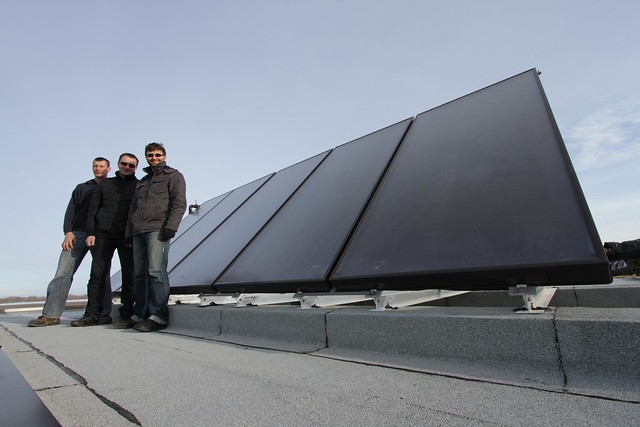By David Dodge and Duncan Kinney
Horace-Bénédict de Saussure, a Swiss naturalist accidentally built a prototype of the first domestic solar thermal hot water system back in 1796 while testing out a scientific hypothesis. Not only did he end up proving the greenhouse effect was a real thing but solar thermal hot water heating is and continues to be an extremely useful invention.
He built a box, painted the bottom of it black, filled it with water, covered it with two layers of glass and left it in the sun. This very basic system actually brings the water to a boil on a sunny day.
“Someday some usefulness might be drawn from this device for it is actually quite small, inexpensive and easy to make,” De Saussure said of his experiment in a quote that proved to be eerily prescient.
In 2011, there were 245 gigawatts worth of solar thermal collectors in 55 different countries representing 4.2 billion people or 61 per cent of the world’s population. I think it’s fair to say that some usefulness has been drawn from this device.
However, since domestic solar thermal hot water systems are competing with cheap natural gas and cheap solar PV there’s talk online that domestic solar hot water is dead. We disagree, domestic solar hot water isn’t dead, it’s just sleeping and we’ll show how, where and why it makes sense regardless of its competitors.
So what is domestic solar thermal hot water anyway?
Very similar to Horace-Bénédict de Saussures little black bottomed box modern solar thermal hot water systems have a solar collector of some kind (whether a flat plate or evacuated tube) that’s put on the roof, collects the sun’s energy and heats up a fluid – typically glycol in Canada because it doesn’t freeze. That hot fluid transfers its heat into your regular cold city water through a simple heat exchanger. Solar thermal hot water systems are supplemental and work in conjunction with an existing hot water heating system.
These systems tend to work better in the summer, but they do work in all seasons as long as the sun is shining. There are variations in the specifics but it’s a relatively simple, mature technology.
The only thing that takes a bit of thought is whether to go with a flat plate or evacuated tube collector. Flat plate collectors are cheaper but produce slightly less heat while evacuated tube collectors are more expensive but give you a slightly higher yield.

The solar thermal collectors on the roof of Terminal 4 at the Edmonton International Airport. Solar hot water systems tend to make more sense in applications that have large and constant demand for hotwater, such as an airport terminal or swimming pool. Dodge, Green Energy Futures
Where does domestic solar hot water make sense?
To find out where it makes sense and to see a solar hot water system in action we went to the Edmonton International Airport.
“It always makes sense in applications when you have a continuous use for heat. Whether that’s heating the building or heating a process… Car washes, laundromats, seniors lodges, restaurants places like this that don’t shut down,” says Bruce Ganske the owner of Magnum Mechanical Systems.
Ganske just recently installed five-panel collector system on the roof of the Terminal Four building at the Edmonton International Airport. The building is run by Executive Flight Centre (EFC) and is an industrial passenger charter that mostly serves planes flying to and from northern Alberta.
Ryan Hammond, the facility manager for EFC says the building has high hot water demand everyday from passengers constantly coming and going.
“It just made sense. First of all we’re reducing our carbon footprint and we are trying to get a start on a larger plan to reduce energy consumption for all of our facilities all throughout Alberta and Canada,” said Hammond. Not only does the solar thermal system make sense with high hot water demand but it also develops EFC’s reputation as a company that puts together quality projects.
The economics of solar thermal
With the price of natural gas currently low the simple payback numbers on a residential domestic solar thermal hot water systems are quite high. The payback period drops if you have big hot water bill or if you use more expensive options to heat your water like heating oil or electricity.
While natural gas is cheap right now, it won’t be forever and a solar thermal hot water system is a valuable hedge against rising natural gas and energy prices, especially in commercial applications.
While some might turn their noses up at the current economics of solar thermal hot water systems less developed countries without our huge natural gas grid are jumping all over the opportunity. China has by far the most installed capacity with 117,600 megawatts of domestic solar thermal hot water systems as of 2010.
Everyone needs warm water to clean their dishes and take a shower. Solar thermal technology has been around, and will be around for a long time to come. Domestic solar hot water is dead, long live domestic solar hot water.
-30-
YEG goes solar: Reducing energy use in an airport is a big challenge
To do our story on solar thermal hotwater we visted historic Terminal 4 at the Edmonton, International Airport where Executive Flight Services Development has installed a solar thermal hot water system in the airport terminal. When you think about it an airport hangar and terminal is an energy efficiency nightmare. To move a plane out of the hanger you open the entire wall of the building exposing it to -30 degree air on a cold winter day. In the terminal you have hundreds or thousands of passengers pouring in and out of the doors.
To make energy efficiency matters worse Executive Flight Centre operates out of a historic building, Terminal 4, the original Edmonton International Airport hanger and terminal.
“This building is a heritage site. It’s been here since 1960 and I can’t see it going anywhere anytime soon. When you look at the next 20-30 years a small thing like solar hot water heating becomes a major factor,” says Ryan Hammon, facilities manager.
Working with old buildings and a long time horizon means companies like EFC Development are very interested in reducing operating costs and even reducing emissions.
“Looking at the design we also added waterless urinals. We have air curtains on the exterior doors. We have condensing boilers that are 97 per cent efficient and we have a unique vestibule access which allows for thermal buffering where the passengers enter the building,” says Hammond.
Walking through the old hangar is like walking through a mechanical systems museum. Old inefficient heating systems have been replaced by new radiant heating systems and LED lights have been added.
Why install a solar thermal hot water system? “The biggest reason for us would probably be tenant retention and operating costs. All of these little things come in – if you can offer a tenant a better facility at a better price it only makes sense,” says Hammond.


